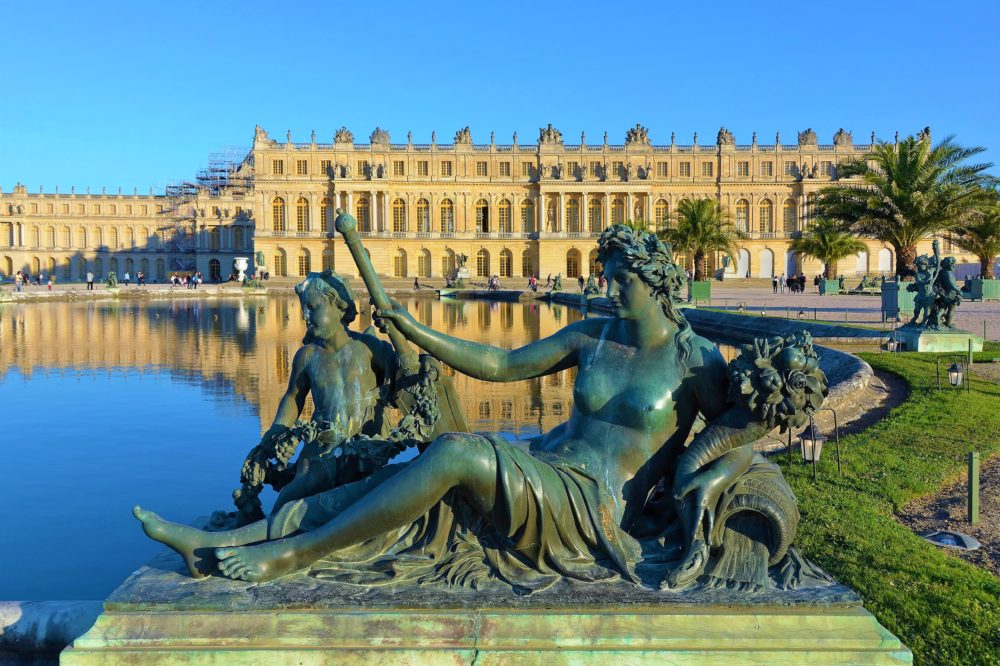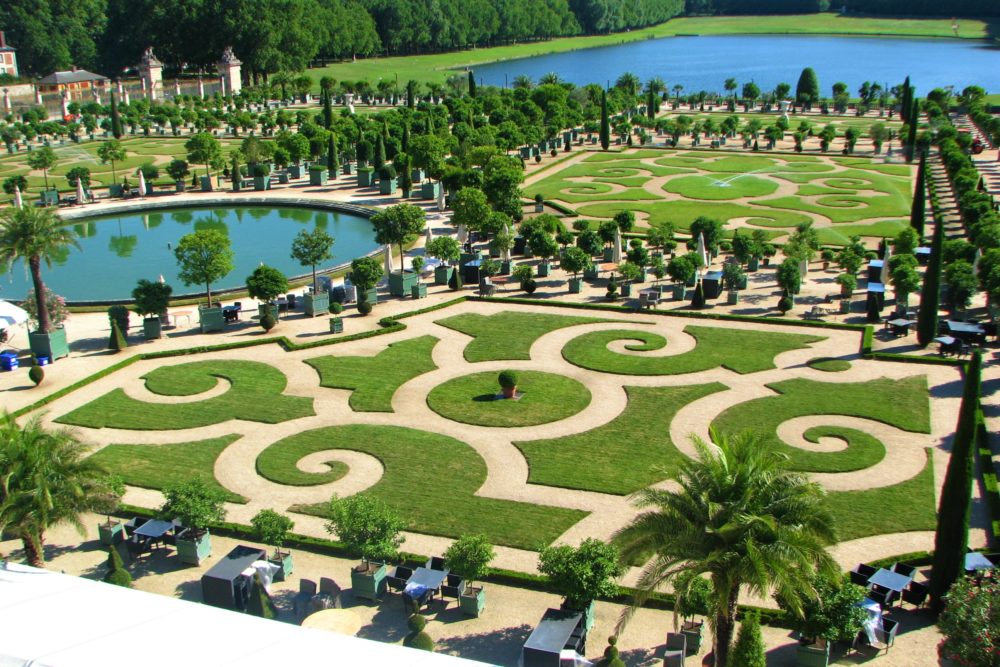Château de Versailles’ dazzling opulence and manicured gardens are a treat in themselves, yet beyond its 17th-century elegance lie a treasure trove of sights, tastes and delights.

Château de Versailles (Photo: Patrick via Flickr / CC BY-SA 2.0)
Lauded for its glamorous chateau, breezy avenues and geometric vantage points, the city of Versailles has long enticed history and culture seekers into its dreamy, antiquated heart. During King Louis XIV’s dramatic 72-year reign over France, aristocratic civil servants built themselves lavish properties, transforming Versailles’ rustic village into a stately town now laced with 17th and 18th century mansions. Merged with a plethora of landscaped parks – and municipal museums, a cathedral and a royal opera house, and a cluster of crackling outdoor markets – Versailles makes for a culturally immersive weekend.
Versailles’ creative spirit doesn’t rest comfortably on its gilded grandeur, its movers and shakers have planted the city firmly in the 21st century. Offering a slew of sleek wine, cocktail and craft beer bars, and numerous foodie hotspots, there’s no need to dash back to the bright lights of Paris for night-time pleasures.
Things to Do
In terms of palatial swagger, Château de Versailles is in a league of its own. Located in Versailles’ leafy environs, from 1682 to 1789 this glorious baroque palace was the kingdom’s political municipality, and Louis XIV’s testament to wealth and power. Spanning over 900 hectares of expansive palace and gardens, the self-proclaimed “Sun King” managed the 40-year construction project personally. Hiring the most prodigious talents of the period, such as architect Louis Le Vau, landscape artist André Le Nôtre and decorative artist Charles Le Brun, Louis’ unbridled indulgence had created one of the world’s most iconic and historic landmarks.

Galerie des Glaces (Photo: Sei F via Flickr / CC BY-SA 2.0)
Kick off the palace tour at the Galerie des Glaces (Hall of Mirrors). Noted for its sparkling 17th-century baroque style, this sprawling hall was where the King held swanky balls and events. Clocking in at 73 metres long, its name alludes to the immense arcaded windows which let in shafts of light, which then bounce off humungous mirrors, flooding the room with luminescence. Daubed on the vaulted ceilings are thirty majestic compositions by Charles Le Brun, which are mainly celebratory distillations of France’s political and economic success. Perhaps most significantly, the Hall of Mirrors is the location where the termination of World War I was officiated on June 28, 1919 in the signing of the Treaty of Versailles.
The Grand Appartement du Roi (The King’s Apartment) furthers the theme of decadence with spectacular salons dedicated to Hercules, Abundance, Venus, Diana, Mars and Mercury.
Designed by André Le Nôtre, the Jardins de Versailles’ colossal space spans 800 hectares and contains 200,000 trees, 210,000 plants, 50 fountains and 620 water jets no less. To put the garden’s magnitude in perspective, the view from outside the Hall of Mirrors flies across the maze-like landscape past the Grand Canal and deep into the horizon. Due to its size, if your time is limited, the garden’s highlights are The Grand Canal (a 1.6km long and 62m wide cross-shaped body of water designed to catch the sunset which dazzles on its surface) and The Orangery which consists of 1,000 orange trees.

Jardins de Versailles (Photo: megancooper14 via Flickr / CC BY 2.0)
Since the days of King Louis XIV, Marché Notre Dame (Rue de la Paroisse) has served as a steady and dependable source of groceries for the people of Versailles. One of France’s most eminent indoor-outdoor markets, it truly captures Versailles’ crackling village atmosphere. A cornucopia of stalls trade an extravaganza of French delicacies from foie gras and cured meats, olives and grapes, to cheeses and fine wines, along with adventurous renditions of France’s beloved macaron.

Royal Opera House (Photo: Tanya Hart via Flickr / CC BY-SA 2.0)
On the tip of the market square, Passage de la Geôle is an arts & crafts enclave where artisans in workshops restore and recreate antique treasures. Its network of atmospheric courtyards is home to a clutch of antique, furniture, jewellery, book and decorative arts shops. It’s also a great spot to stop off for a tea, coffee or bite to eat in one of the cafés strewn throughout the surrounding area.
Debuting In 1770 to denote the marriage of Louis XVI to the young Marie-Antoinette, the spectacular ovular-shaped Royal Opera House (3 Place Léon Gambetta) was once recognised as the most sophisticated 18th-century opera house in Europe. Today, the Opera House functions as an eminent fixture on the itinerary of world-class theatre, orchestra and opera productions.
Where to Stay
Set on the lip of the Gardens of Versailles, Trianon Palace – Waldof Astoria Versailles (1 Boulevard de la Reine) is one of the city’s swishest hotels. Light-flooded rooms with fresh, regal décor revel in elegant cosiness. Replete with an award-winning spa, indoor swimming pool and Gordon Ramsay fine-dining experience, Trianon Palace puts the ritz in the retreat.
Facing the Palace of Versailles, the Hôtel de France (5 Rue Colbert) retains the spirit of that golden age with period furniture, flamboyant wallpaper and antiquated sculptures. Rooms at this elegant establishment come in rich colours and feature gilded window frames and plush sofas. The hotel’s restaurant, La Taverne de Maître Kanter, serves up splendid culinary delights from France’s Alsace region.
If you’re on a tight budget, Hôtel d’Angleterre (2 Bis Rue de Fontenay) is easy on the pocket. Rooms in this welcoming hotel are bright, colourful and modern. The general tone is simple but cosy.
Eat & Drink
L’Alcove (2 Bis Avenue de Paris), a vibrant bar in the Hôtel Le Louis Versailles Château continues the palace’s eye-popping aesthetic with a contemporary twist. Arched skylights and streamlined colonnades frame a glowing amber-colored circular bar, where sommeliers concoct tantalising cocktails including Le Roi Soleil and Marie Antoinette.

L’Alcove Bar (Photo: Booking.com)
Steps away from the Château de Versailles, Michelin-starred La Table du 11 (8 Rue de la Chancellerie) beholds a chic presence in the cobbled Cour des Senteurs (Courtyard of Fragrances). Upmarket, yet with reachable prices, La Table du 11 bestows a small menu that features market-fresh produce: lobster with white truffle, radish leaves and mushrooms, and Argentine beef with roasted pumpkin and cheese buratta are a snapshot of what’s on offer. Its sister restaurant Le Bistro du 11 (10 Rue de Satory) is also worth a visit.
The homely and earthy ambiance of L’Equilibre Wine Bar (8 Rue des Deux Portes) immediately puts you at ease. Crammed with bottles and barrels from floor to ceiling it has the feel of an old market bar, with sleek canteen furniture giving it a modern sheen. Its claret red fascia is a complementary backdrop to the terrace that hums with chatter. Locals and visitors chow-down on specialities such as tapas platters with a Basque influence, and Savoyard sandwiches, washed down with a glass or two from its rotating wine list.
Parisian beer, French beer and beer from around the world are what’s on offer at the Craft Beer Lab (6 Rue des Récollets). Located on a discreet street close by, yet a world away from the Château de Versailles, beer connoisseurs and affable guides Alexei and Baptiste will happily extol the history and virtues of every single can or bottle on their shelves that positively sing with beer.